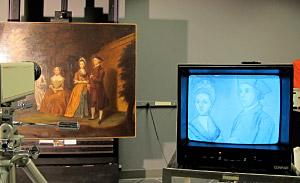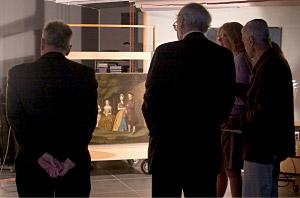
Sarah Gowen, American Art's Paintings Conservation Intern, gives us a behind the scenes look at how we solved a painting mystery.
In 2006, the Smithsonian American Art Museum acquired The Wiley Family, a group portrait painted by William Williams in 1771. The painting is said to have been handed down through the Wiley family by the son depicted in the portrait. Recently, a privately owned copy of the painting was brought to the Lunder Conservation Center for examination and comparison to the original. It was thought that Williams himself was commissioned at a later date to paint the copy for another member of the Wiley family. Several outside scholars and American Art curators met with conservators at Lunder to discuss the two paintings.
Examination of the copy revealed the inscription "PAINTED BY F.W. Wright AFTER WM WILLIAMS 1771" on the reverse of the canvas. Frederick William Wright (born in 1880) was an American portrait painter active in New York. When his painting was placed next to the original, the experts were able to distinguish subtle stylistic differences between the paintings. Based on this new information, the planned discussion about why Williams would have created the copy shifted to a conversation about why Wright copied the painting over one hundred years after the original was made and how he was able to paint such an accurate reproduction.
To further examine both group portraits, paintings conservators used infrared reflectography (IRR) to investigate possible underdrawings beneath the paint. IRR allows conservators to "see through" paint and look for hidden images or compositional changes. The original painting by Williams does not have an underdrawing visible in infrared; however, IRR revealed that Wright's copy does, and it showed us how he created his painting! A well-defined drawing as well as the remains of a grid and numbering system can be seen using IRR. These markings indicate that Wright used grid measurements to replicate the image to near perfect scale. He then painted the picture, likely while looking at the original painting, to create his accurate copy.
Although we don't know why Wright painted the copy, this process shows the benefits of comparing artworks side by side and using IRR to see drawings beneath the paint. The artistic nuances between the two paintings and the different methods used by Wright and Williams confirmed the information in Wright's inscription—that the second painting was not by Williams.
We have posted additional photographs on Facebook taken during the examination of these paintings.


















